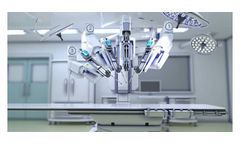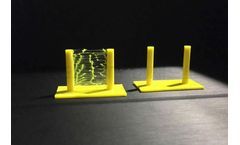Refine by
Bioprinting Articles & Analysis
23 articles found
Enzyme-based bioinks are being developed for 3D bioprinting, creating living materials with tailored functions—offering tremendous promise for regenerative medicine and tissue engineering. ...
Technologies such as the shoulder CPM (continuous passive motion) device and light-based bioprinters are redefining rehabilitation and regenerative medicine. From general surgery tables designed for optimal patient positioning to new muscle treatment approaches, medical equipment continues to evolve, ensuring better outcomes and improved patient ...
Bioactive factors: These are growth factors, nutrients, and other signaling molecules that can help the cells to survive, proliferate, and differentiate into the desired tissue type. How Does Bioprinting Work? Bioprinting is a complex process that involves using a specialized 3D printer to deposit layers of bio-ink onto a platform. ...
ByMatexcel
Connon, and Stephen Swioklo (2023), have successfully shown that Atelerix BeadReady™ is a simple, adaptable solution for room temperature cell storage in combination with biofabrication and how this can be integrated for on-demand bioprinting. Abstract Over the last decade, progress in three dimensional (3D) bioprinting has advanced considerably. ...
Co-founder Ryan Bethencourt is one of the investors behind Sustainable Food Ventures Cultivated Meat Startups Landscape: Enabling Technologies Here’s the full list in alphabetical order: Agulos Biotech (US, 2017, cell culture media) — developing Simulated Platelet Lysate (porcine), a replacement for FBS Back of the Yards Algae Sciences (US, 2018, cell culture media) — algae ...
The selected 3D bioprinting approach offers an attractive tool for fabrication of 3D in-vitro human alveolar lung models. ...
ByRegenhu
The bioinspired hydrogel composition and processing parameters were optimized to improve the quality of the constructs fabricated through micro-extrusion technology by means of REGENHU 3D Bioprinters. By exploiting the dedicated design software and high-accuracy automated calibration mechanisms of the system, researchers were able to perform the process directly within Petri ...
ByRegenhu
The bioprinted constructs allowed the in vitro study of chondrogenic signaling pathways, as well as the role of TGF-β signaling. ...
ByRegenhu
The aim of this study was to develop a bioprinting strategy to engineer prevascularised tissues in vitro and to investigate the capacity of such constructs to enhance the vascularisation and regeneration of large bone defects in vivo. ...
ByRegenhu
These Allevi Authors set out to develop a natural method for sustained oxygen release into an engineered tissue and found a solution in nature. Their novel bioprinting method uses an Allevi 2 bioprinter and a bioink that incorporates photosynthetic single-celled green algae called Chlamydomonas reinhardtii. ...
To achieve this, the researchers lowered both GelMA and LAP photoinitiator concentrations in their final constructs to as low as 5% and 0.1% w/v, respectively. They bioprinted the constructs using an Allevi 2 bioprinter and the following parameters: Print Speed (mm/s)Tip GaugeTemperature (C)Pressure (PSI)Crosslinking IntensityCrosslinking Time (s)Crosslinking ...
Jean-Yves Coste, Senior Healthcare Director of Michel Dyens & Co. in Paris spoke on trends in medical aesthetics, including telediagnoses, digital imaging, 3D bioprinting in reconstructive surgery, and what he referred to as IOMT (Internet of Medical Things). ...
Researchers are curious about how microgravity can facilitate bioprinting and the growth of cells and tissues. At the same time, the recent use of this technology in space to examine other medical problems has also interested them, such as radiation and human problems. ...
Utilization of a bioprinter allows for the generation of large numbers of uniform and highly reproducible organoids in reduced time (approximately 20x faster) compared to manual processes. Treatment of bioprinted kidney organoids cultured in conventional 6-well format with doxorubicin exhibited concentration-dependent morphological changes consistent with cell ...
Publication Summary: The identification of targets and biomarkers and development of therapeutics for nonalcoholic fatty liver disease (NAFLD) may be accelerated by the use of well-characterized primary cell and tissue reagents, as well as improved in vitro human cell-based disease models, including three-dimensional (3D) bioprinted liver tissue. The characteristics of donors ...
On March 5, 2019, the Lawrence Livermore National Laboratory (LLNL) announced that their researchers have 3D printed live cells that are able to convert glucose to ethanol and carbon dioxide gas. The substance produced from this conversion resembles beer. This means that this newly developed technology can lead to highly efficient biocatalysis. According to LLNL’s announcement, the use ...
Publication Summary: The growing global incidence of NASH mirrors the availability of nutrients. Over-nutrition also results in insulin resistance and type-2 diabetes, which are often co-morbidities associated with NASH and are known to drive more adverse outcomes. MSDC-0602K, a modulator of the mitochondrial pyruvate carrier (MPC), is in clinical trials as a potential treatment for NASH. ...
Publication Summary: Nonalcoholic fatty liver disease (NAFLD) is a chronic condition that originates as lipid accumulation within hepatocytes (steatosis) and progresses into nonalcoholic steatohepatitis (NASH), characterized by lipid accumulation, inflammation, oxidative stress, and fibrosis. NAFLD is now recognized as the most common cause of chronic liver disease in the western world, with an ...
Evaluation of potential antifibrotic therapies are limited using conventional non-human animal models, due to their inability to accurately reflect complex in vivo human biology, while 2D models lack the multicellular complexity and life span required to study fibrosis progression and regression. Utilization of a human 3D-bioprinted liver tissue model (ExVive™ Human Liver ...
Publication Summary: Nonalcoholic fatty liver disease (NAFLD) is a chronic condition that originates as lipid accumulation within hepatocytes (steatosis) and progresses into nonalcoholic steatohepatitis (NASH), characterized by lipid accumulation, inflammation, oxidative stress, and fibrosis. NAFLD is now recognized as the most common cause of chronic liver disease, with a prevalence of 25% ...











